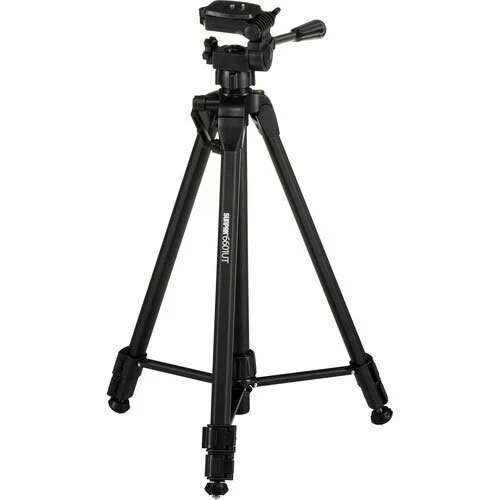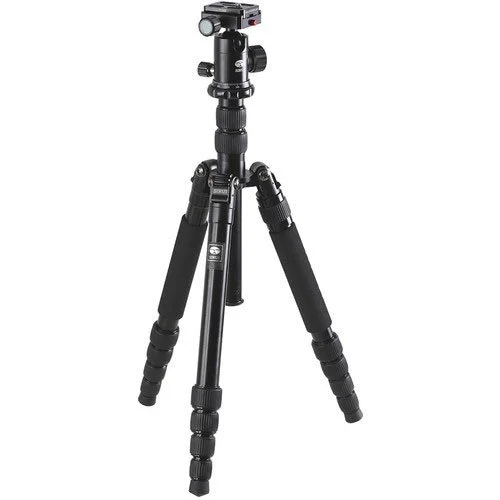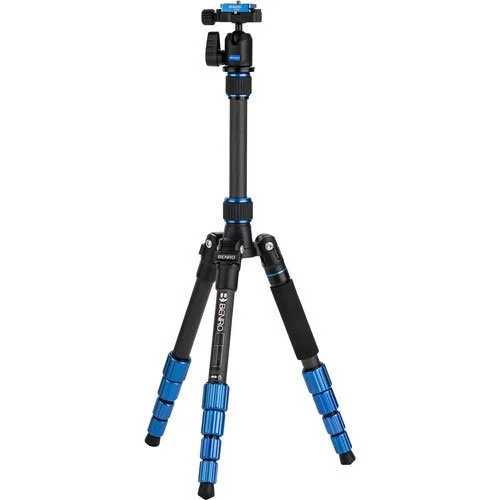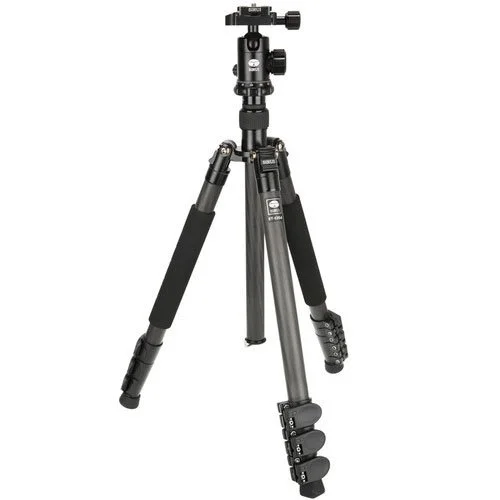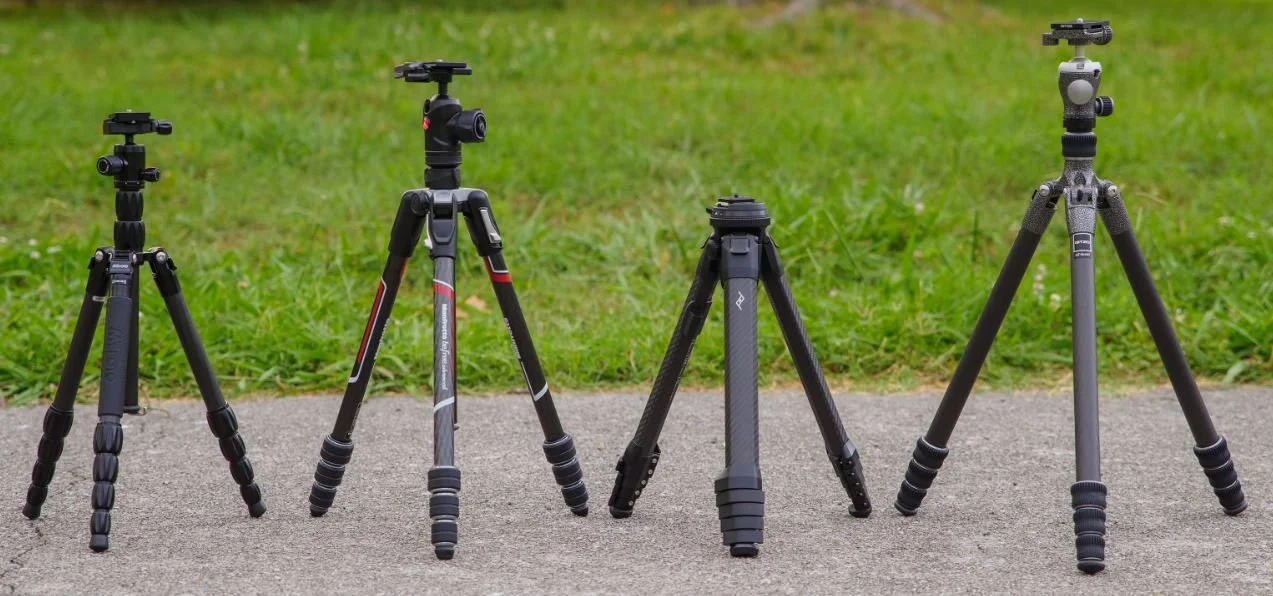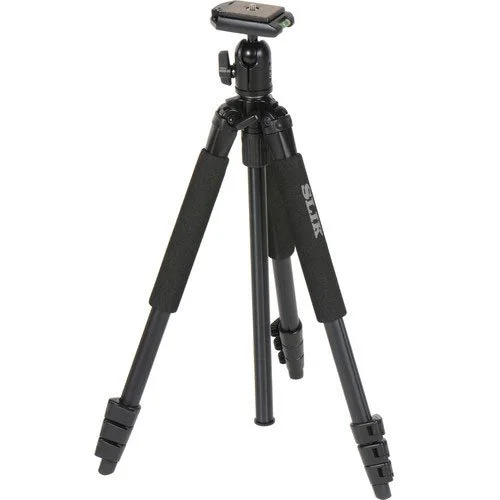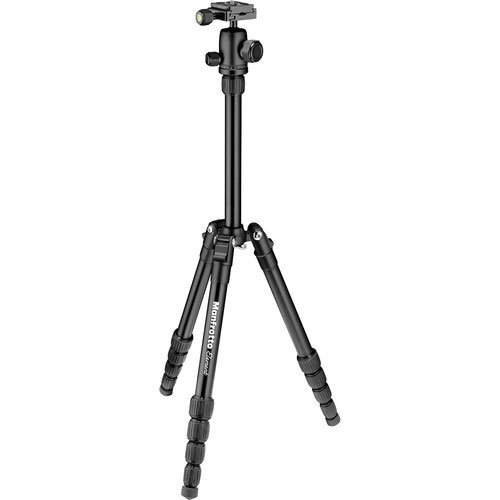Best Lightweight Tripod for Backpacking
Learn how much your backpacking tripod should weigh, and what options are available for any budget.
If you're a backpacker or outdoor enthusiast, you know that every ounce counts. When it comes to equipment, finding lightweight options is key to enjoying your trip to the fullest.
A tripod is an essential piece of equipment for any photographer, videographer, or sound recordist, but a traditional tripod can be bulky and heavy. Fortunately, there are plenty of lightweight tripods on the market that won't weigh down your backpack.
In this blog post, we'll explore some of the best lightweight tripods for backpacking, and help you choose the right one for your needs.
Backpacking Tripod FAQ
-
The weight of a backpacking tripod can vary depending on your needs and preferences, but generally, a good rule of thumb is to look for a tripod that weighs no more than 2-3 pounds.
This is light enough to carry on a backpacking trip without adding too much weight to your pack, but still sturdy enough to provide stable support for your camera.
However, if you are willing to carry a bit more weight for added stability and durability, there are also lightweight tripods that can handle up to 10-15 pounds of camera gear, while still weighing around 3 pounds.
Ultimately, the weight of your tripod will depend on your specific needs and the type of backpacking you plan to do.
-
Carbon fiber is often considered the strongest yet lightest material for tripod legs.
Carbon fiber is a lightweight and durable material that is commonly used in high-performance applications, such as aircraft and race cars.
Carbon fiber tripods are typically lighter than aluminum or steel tripods, but also more expensive.
Carbon fiber is also highly resistant to bending and torsion, making it an excellent choice for photographers who need a lightweight and sturdy tripod that can handle heavy loads.
However, it's important to note that the strength of a tripod also depends on its design and construction, and not just the material used.
A well-designed tripod with high-quality materials and construction will provide optimal support and stability for your camera gear, regardless of the material used.
-
The height of a travel tripod will depend on your needs and preferences.
However, generally, a good rule of thumb is to look for a travel tripod that extends to around eye level when fully extended.
This will allow you to take photos and videos without having to bend over or crouch down, which can be uncomfortable and lead to camera shake.
For most people, a tripod that extends to around 50-60 inches (127-152 cm) will be sufficient.
It's also important to consider the minimum height of the tripod, which will affect your ability to take low-angle shots.
Look for a tripod with a minimum height that allows you to get your camera close to the ground, which is typically around 5-6 inches (13-15 cm).
Best Lightweight Tripod for Backpacking
Tripods come in two primary materials: aluminum and carbon fiber.
Since both materials are valid options for backpacking use, I’ve split the recommendations into two categories below:
Remember, although aluminum tripods are heavier, they’re cheaper, more stable, and more durable than carbon fiber options.
Carbon fiber tripods are the best choice for weight-savings, but they’re more expensive and you may need to hang your pack from the central column to help steady the tripod in windy conditions or on uneven terrain.
For more information, please see the “How To Choose A Lightweight Tripod” section.
Best Aluminum Tripods for Backpacking:
Shoestring Budget: Sunpak 6601UT ($)
Lightest: Slik Sprint 150 ($)
Editor’s Choice: Manfrotto Element Small ($$)
For Heavy Camera/Lens: Sirui A1005 ($$)
Best Carbon Fiber Tripods for Backpacking:
Lightest: Benro Slim Travel Tripod ($$)
For Heavy Rigs: Sirui ET-1204 Carbon Fiber Tripod ($$$)
Best Aluminum Tripods for Backpacking
Aluminum tripods are great for their stability, durability, and price.
Below you’ll find several lightweight aluminum tripods recommended for backpacking.
The results are sorted by price, from low to high.
Shoestring Budget:
The Sunpak 6601UT Tripod with 3-Way, Pan-and-Tilt Head is a versatile and affordable option for backpackers on a serious budget. Here's a review of this tripod's features and how it can work for backpacking:
Weight and Portability:
The Sunpak 6601UT weighs in at just 2.4 pounds, which makes it lightweight and easy to carry on a backpacking trip. It also has a compact design, with a folded length of just 22 inches, making it easy to strap to a backpack.
Height:
The Sunpak 6601UT can reach a maximum height of 59 inches, which is tall enough for most people. The minimum height is 24 inches, which may be too high for some low-angle shots. The height is adjustable by using the quick-release leg locks, which are easy to adjust.
Stability:
The Sunpak 6601UT is a sturdy tripod that can support up to 8 pounds, which should be enough for most backpackers' cameras and lenses. The legs are made of aluminum, which makes them strong and durable. The rubber feet provide good traction on most surfaces, although the tripod doesn't come with spikes for use on uneven or soft terrain.
Head:
The 3-way pan-and-tilt head can be awkward to use if you’re not familiar with this style, although it is quickly learned. The head can be adjusted to pan left and right, tilt up and down, and rotate the camera horizontally.
Price:
The Sunpak 6601UT is one of the most affordable tripods on the market, making it a good choice for backpackers who are on a budget. It is less expensive than many other tripods in its class, making it an attractive option for those who want a sturdy tripod without breaking the bank.
Bottom Line: If you’re a backpacker on an extremely small budget, the Sunpak 6601UT is a solid option. However, the 3-way pan-and-tilt head is awkward to learn and not as fast as a ball head for setting up your composition. If you have a little more to spend, there are much better options available.
| Material | Weight | Folded Length | Max Height | Min Height | Load Capacity |
|---|---|---|---|---|---|
| Aluminum | 2.4 lb / 1.1 kg | 22.5" / 57.2 cm | 59" / 149.9 cm | 23.8" / 60.5 cm | 8 lb / 3.6 kg |
Lightest:
For about twice the price of the Sunpak 6601UT (above), the Slik Sprint 150 Tripod is a lightweight and portable option for backpackers who want a sturdy and reliable tripod without adding too much weight to their pack.
Weight and Portability:
The Slik Sprint 150 weighs in at just 2.3 pounds, making it the lightest full-size aluminum tripod on the market. It also has a compact design, with a folded length of just 20 inches, making it easy to strap to a backpack.
Height:
The Slik Sprint 150 can reach a maximum height of 64.4 inches, which is tall enough for most people. The minimum height is 7.4 inches, which is ideal for low-angle shots. The height is adjustable by using the quick-release leg locks, which are easy to adjust.
Stability:
The Slik Sprint 150 is a sturdy tripod that can support up to 4.5 pounds, which may not be enough for large telephoto lenses, but should be enough for most lightweight setups. The legs are made of aluminum, which makes them strong and durable. The rubber feet provide good traction on most surfaces, although the tripod doesn't come with spikes for use on soft or uneven terrain.
Head:
The SBH-150DQ ball head is easy to use and provides a good range of motion. The head can be adjusted to pan left and right, tilt up and down, and rotate the camera horizontally.
Price:
The Slik Sprint 150 is an affordable option, making it a good choice for backpackers who are on a budget. It is less expensive than many other tripods in its class, making it an attractive option for those who want a sturdy tripod without breaking the bank.
Bottom Line: The Slik Sprint 150 is a great option for backpackers. It’s the lightest full-size aluminum tripod on the market and is still relatively affordable. If you’re a backpacker with a point-and-shoot camera, or other lightweight setups, the Slik Sprint 150 is a great choice. However, with support for only 4.5 pounds, the head may not be able to support telephoto lenses and professional camera bodies.
| Material | Weight | Folded Length | Max Height | Min Height | Load Capacity |
|---|---|---|---|---|---|
| Aluminum | 2.3 lb / 1 kg | 19.9" / 50.5 cm | 64" / 162.5 cm | 7.4" / 18.8 cm | 4.5 lb / 2 kg |
Editor's Choice:
The Manfrotto Element Small Aluminum Traveler Tripod is the top-recommended lightweight tripod for backpacking. It’s lightweight, very compact, full-size, sturdy enough for large lenses and professional camera bodies, and features a fast ball head and a fair price.
Weight and Portability:
The Manfrotto Element Small Aluminum Traveler Tripod weighs in at just 2.5 pounds, which makes it easy to carry on a backpacking trip. It also has an extremely compact design, with a folded length of just 12.6 inches, making it easy to strap to a backpack.
Height
The Manfrotto Element Small can reach a maximum height of 56 inches, which is tall enough for most people. The center column can be adjusted, which allows for additional height if needed. The minimum height is 14 inches, which is the lowest so far, but may still be too high for some low-angle shots. The height is adjustable by using the quick-release leg locks, which are easy to adjust.
Stability:
The Manfrotto Element Small is a sturdy tripod that can support up to 13.2 pounds, which should be enough for most backpackers' cameras and lenses and is even suitable for longer telephoto lenses on professional camera bodies. The legs are made of aluminum, which makes them strong and durable. The rubber feet provide good traction on most surfaces, although the tripod doesn't come with spikes for use on soft or uneven terrain.
Head:
The ball head is easy to use and provides a good range of motion. The head can be adjusted to pan left and right, tilt up and down, and rotate the camera horizontally. The ball head is great for general photography and videography.
Price:
The Manfrotto Element Small is a relatively affordable option, making it a good choice for backpackers who are on a budget. It is less expensive than many other tripods in its class, making it an attractive option for those who want a sturdy tripod without breaking the bank.
Bottom Line: Manfrotto is one of the most trusted brands when it comes to tripods. The Element Small is no exception and is made very well and stable enough for most professional wildlife photography setups. In my opinion, this is the best aluminum tripod for backpacking.
| Material | Weight | Folded Length | Max Height | Min Height | Load Capacity |
|---|---|---|---|---|---|
| Aluminum | 2.5 lb / 1.2 kg | 12.6" / 32 cm | 56.3" / 143 cm | 14.2" / 36 cm | 13.2 lb / 6 kg |
Best Overall Aluminum:
The Sirui A1005 Aluminum Tripod with Y-10 Ball Head is the best aluminum lightweight tripod for backpacking. Despite being 0.1 pounds heavier than the Manfrotto Element Small (above), the Sirui A1005 has a minimum height of just 5.3” and can support virtually any camera setup, up to 22 pounds.
Weight and Portability:
The Sirui A1005 weighs in at just 2.7 pounds, which makes it easy to carry on a backpacking trip. It also has a compact design, with a folded length of just 14 inches, making it easy to strap to a backpack.
Height:
The Sirui A1005 can reach a maximum height of 55 inches, which is tall enough for most people. The minimum height is 10.2 inches, which is low enough for low-angle shots. The height is adjustable by using the quick-release leg locks, which are easy to adjust.
Stability:
The Sirui A1005 is a sturdy tripod that can support up to 22 pounds, which should be more than enough for most backpackers' cameras and lenses. The legs are made of aluminum, which makes them strong and durable. The rubber feet provide good traction on most surfaces, and the tripod also comes with spikes for use on uneven terrain.
Head:
The Y-10 ball head is easy to use and provides a good range of motion. The head can be adjusted to pan left and right, tilt up and down, and rotate the camera horizontally. The ball head also has a separate knob for adjusting the tension of the ball, which allows for more precise adjustments.
Price:
The Sirui A1005 is a mid-range option, making it a good choice for backpackers who want a high-quality tripod without breaking the bank. It is more expensive than some other tripods in its class, but it offers a great balance of features and price.
Bottom Line: If you have a little more to spend, the Sirui A1005 is the best aluminum lightweight tripod for backpacking. Despite being very light at only 2.7 pounds, the A1005 has professional features not common for tripods in this price range such as: 22 pound load capacity, dedicated tension knob for precise adjustments, and spiked feet for use on soft or uneven terrain.
| Material | Weight | Folded Length | Max Height | Min Height | Load Capacity |
|---|---|---|---|---|---|
| Aluminum | 2.7 lb / 1.22 kg | 14" / 35.6 cm | 55.1" / 140 cm | 10.2" / 25.9 cm | 22 lb / 10 kg |
Best Carbon Fiber Tripods for Backpacking
Carbon fiber tripods are great for their fantastic strength-to-weight ratio.
Below you’ll find several lightweight carbon fiber tripods recommended for backpacking.
The results are sorted by price, from low to high.
Lightest:
The Benro Slim Travel Tripod is an ultra lightweight and compact option for backpackers who want a sturdy and reliable tripod without adding too much weight to their pack. Here's a review of this tripod's features and how it can work for backpacking:
Weight and Portability:
The Benro Slim Travel Tripod weighs in at just 2.35 pounds, which makes it the lightest tripod featured in this post. It also has a compact design, with a folded length of just 14.2 inches, making it easy to strap to a backpack.
Height:
The Benro Slim can reach a maximum height of 51.2 inches, which is tall enough for most people. The minimum height is 12.4 inches, which is ideal for low-angle shots. The height is adjustable by using the twist-lock leg system, which is easy to use.
Stability:
The Benro Slim can support up to 8.8 pounds, which should be enough for most backpackers' cameras and lenses. The legs are made of carbon fiber, which makes them strong and durable. The rubber feet provide good traction on most surfaces, although the tripod doesn't come with spikes for use on soft or uneven terrain.
Head:
The ball head is easy to use and provides a good range of motion. The head can be adjusted to pan left and right, tilt up and down, and rotate the camera horizontally. The ball head is great for general photography and videography, although it may not be suitable for more specialized shots.
Price:
The Benro Slim is a mid-range option, making it a good choice for backpackers who want a high-quality tripod without breaking the bank. It is more expensive than some other tripods in its class, but it offers a great balance of features and price.
Bottom Line: The Benro Slim Travel Tripod is one of the cheapest and lightest full-sized tripods on the market. This is the tripod I personally use and I love it. I use it with a Panasonic GH5 and Lecia 100-400mm lens with no stability issues. If you’re looking for the lightest possible tripod that’s capable of supporting professional camera rigs, look no further.
| Material | Weight | Folded Length | Max Height | Min Height | Load Capacity |
|---|---|---|---|---|---|
| Carbon Fiber | 2.4 lb / 1.01 kg | 12.9" / 32.8 cm | 51.2" / 130 cm | 12.40" / 31.5 cm) | 8.8 lb / 3.99 kg |
Best For Heavier Setups:
The Sirui ET-1204 Carbon Fiber Tripod with E-10 Ball Head is a high-quality and lightweight option for backpackers who want a tripod that is both sturdy and portable.
Weight and Portability:
The Sirui ET-1204 weighs in at just 3.1 pounds, which makes it easy to carry on a backpacking trip. It also has a compact design, with a folded length of just 16.5 inches, making it easy to strap to a backpack.
Height:
The Sirui ET-1204 can reach a maximum height of 55 inches, which is tall enough for most people. The minimum height is 5.3 inches, which is low enough for low-angle shots. The height is adjustable by using the twist-lock leg system, which is easy to use.
Stability:
The Sirui ET-1204 is a sturdy tripod that can support up to 18 pounds, which is enough for virtually any camera rig setup. The legs are made of carbon fiber, which makes them strong and durable, yet lightweight. The rubber feet provide good traction on most surfaces, and the tripod also comes with spikes for use on soft or uneven terrain.
Head:
The E-10 ball head is easy to use and provides a good range of motion. The head can be adjusted to pan left and right, tilt up and down, and rotate the camera horizontally. The ball head also has a separate knob for adjusting the tension of the ball, which allows for more precise adjustments.
Price:
The Sirui ET-1204 is a more expensive option, with professional-level features.
Bottom Line: For backpackers with super telephoto lenses and professional camera bodies, the Sirui ET-1204 is a great, lightweight option. With support for up to 18 pounds, included spiked feet, and dedicated tension knob for precise adjustments, it’s a great choice for professional photographers and videographers who often find themselves working deep in the wilderness.
| Material | Weight | Folded Length | Max Height | Min Height | Load Capacity |
|---|---|---|---|---|---|
| Carbon Fiber | 3.1 lb / 1.4 kg | 16.5" / 42 cm | 55" / 140 cm | 5" / 13 cm | 18 lb / 8 kg |
How To Choose A Lightweight Tripod
When it comes to choosing a lightweight tripod for backpacking, there are several important features that you should consider. These features will help you determine which tripod is best suited for your specific needs and requirements. Here are some of the most important features to consider:
Weight:
The weight of the tripod is a crucial factor to consider when backpacking, as every ounce counts. A lightweight tripod can make all the difference in how easy it is to carry on a hike. You should look for tripods that are made of lightweight materials like carbon fiber or aluminum, as these materials can significantly reduce the overall weight of the tripod.
Height:
The height of the tripod is another important factor to consider, as it determines how high you can position your camera. When choosing a tripod, make sure it is tall enough to suit your needs. Most tripods have a minimum height of around 20 inches, while others can extend to over 60 inches. Make sure the tripod you choose can be adjusted to the height you need.
Stability:
A tripod needs to be stable to get a good shot. When choosing a tripod, look for one that has sturdy legs and can be securely anchored to the ground. Tripods with adjustable legs and center columns are more versatile and can provide more stability on uneven terrain.
Portability:
The portability of a tripod is another important factor to consider when backpacking. Look for tripods that can be folded down to a compact size, making them easy to pack and carry. A tripod with a carrying case or bag can also make it easier to transport.
Weight capacity:
Make sure the tripod you choose can hold the weight of your camera and any accessories you'll be using. Check the maximum weight capacity of the tripod before making a purchase.
Versatility:
A tripod that can be used in a variety of situations is ideal for backpacking. Look for tripods with adjustable legs that can be used at different angles, as well as center columns that can be reversed for low-angle shots. Some tripods also have removable legs that can be used as a monopod, providing even more versatility.
Price:
The price of a tripod is an important consideration for many people. While high-end tripods can be very expensive, there are plenty of affordable options that provide good value for money. Look for tripods that provide the features you need at a price that suits your budget.
Aluminum vs. Carbon Fiber
When it comes to choosing the best lightweight tripod for backpacking, one of the key decisions you'll need to make is whether to go for an aluminum or carbon fiber tripod.
Both materials have their own advantages and disadvantages, so it's important to consider them carefully before making a decision. Here are the pros and cons of aluminum vs carbon fiber tripods:
Aluminum Tripods:
Pros:
Affordable: Aluminum tripods are generally more affordable than carbon fiber tripods, making them a great choice for those on a budget.
Durable: Aluminum is a strong and durable material that can withstand a lot of wear and tear.
Sturdy: Aluminum tripods are often heavier than carbon fiber tripods, which can make them more stable and less likely to shake or wobble.
Cons:
Heavy: Aluminum tripods can be significantly heavier than carbon fiber tripods, which can make them less suitable for backpacking or long hikes.
Less vibration absorption: Aluminum tripods are not as good at absorbing vibrations as carbon fiber tripods, which can make them less stable in windy conditions or when using longer exposure times.
Carbon Fiber Tripods:
Pros:
Lightweight: Carbon fiber is a lightweight material, which makes carbon fiber tripods ideal for backpacking and other outdoor activities.
Strong: Despite their lightweight design, carbon fiber tripods are incredibly strong and can handle a lot of weight.
Vibration absorption: Carbon fiber is better at absorbing vibrations than aluminum, which makes carbon fiber tripods better for sound recording purposes.
Cons:
Expensive: Carbon fiber tripods are generally more expensive than aluminum tripods, which can put them out of reach for some people.
Less Durable: While carbon fiber is strong, it is more susceptible to damage than aluminum, and may not be a good choice for those tough on gear. If you choose to purchase a carbon fiber tripod, be sure to treat it with care.
Peace of mind. Worrying about the integrity of your setup is stressful and doesn’t make for an enjoyable outing. When using a quality tripod, you can relax knowing that your equipment is in good hands and focus on your work.
Stability. Tripod design focuses on stability first and features second. This stability prevents vibrations caused by wind and low-frequency sounds from being transferred to your camera/recorder.
Any terrain. When out in the field, we never know exactly where we are going to set up our gear. The area may be uneven, steep or even underwater! Having a tripod keeps all these options open thanks to its individually adjustable legs.
Any height. Having a tripod will allow you to record anywhere from a few inches to 5+ feet above the ground. This range of height gives your compositions unrivaled creative possibilities.
Features To Consider
Head Type
The tripod’s head sits between your gear and the tripod itself. It controls the angle and position of your recorder and is fully adjustable. The way these adjustments are made depends on the type of head in use. There are 4 different kinds but most are designed specifically for photography and videography.
Example of a tripod ball head.
The best head for field recording is the ball head. This is the most modern and popular tripod head because of its ease of use, stability and compact size.
With only one control, the position can be changed 360° and locked into place. Not only is this easy, it is highly efficient. You will spend less time setting up your recording with a ball head.
Height
Not only is the maximum height an important factor when selecting a tripod, but the minimum height is equally important. To give yourself the most flexibility in the field, you want a tripod that can go from head height to a few inches above ground.
Recording an atmosphere at head height will give realism to your sound. We are used to hearing environments at this height and will notice a difference if the recording is too high or too low. The next time you’re out, listen to an atmosphere from a standing position, and then from a squat. You’ll hear a huge difference in sound.
Alternatively, it can be interesting to record from a low perspective. This offers us a unique experience of sound. Some of my favorite sounds to record from a low height are flowing water, grass in the wind and animals. Getting down to these sounds captures subtle details that we miss when walking by.
Weight
Weight can be critically important if you have to travel or hike to reach your sounds. In these cases, a lighter tripod will make for a more enjoyable experience. As previously mentioned, the tripod’s material will be the main factor here, but there are heavy and light options for each material.
In other scenarios, heavy tripods are more suitable. When recording in high winds, on rocky terrain, or when leaving your gear unattended, a heavier tripod will give you more peace of mind thanks to its superior stability. I frequently record in the mountains where I face these conditions and I opt for a heavier, aluminum tripod.
Quick Release
Highlighted diagram of a quick release plate.
A quick release feature is a must for any tripod. By flipping a switch, you can instantly remove whatever is attached to the tripod. This saves a ton of time by allowing you to quickly change between recorders, microphones or other attachments and greatly speeds up setup and take-down time.
This works by screwing a plate into the tripod socket on your equipment. The plate then slides onto the tripod head and is secured into place by a friction switch. Releasing this switch frees up the plate and it can be removed easily.
To save even more time, purchase a quick release plate for each of your most commonly used tools. This will make exchanging them even faster.
Folded Length
Having a tripod that packs down into a small-sized package is really convenient, and if you’re a traveler, it could be a necessity. In order to meet the shrinking luggage constraints, having a compact tripod is a must.
The most compact tripods can fold down to just 12” / 30.5cm in length. However, tripods this compact are shorter than others with a maximum height of around 55” / 139cm.
Leg Lock
The legs of a tripod are made of several sections. The sections nest within each other to save space. To set a tripod up, the sections must be released and locked into the desired position. There are two mechanisms for achieving this: flip locks and twist locks.
Flip locks and twist locks are two methods for securing the different sections of tripod legs.
Flip Locks
Flip locks are popular due to their ease of use and rapid setup time. Simply “flip” the locking clasp open to extend the leg, and flip the clasp closed to secure it in place. The amount of tension can be increased should the lock ever become loose by tightening the clasp’s screw. This quick fix can be done in the field and adds longevity to the mechanism.
Twist Locks
Twist locks can intimidate people who believe they are difficult to use. However, after a little practice, twist locks can actually be easier and faster to use than some flip locks. For maximum efficiency, remember that only a quarter-turn is needed to release and lock each leg section.
Summary
Best Aluminum Tripods for Backpacking:
Best Carbon Fiber Tripods for Backpacking:
I hope this article has helped you in your decision making process. If it has, let me know! I would love to hear from you.
If you already have a tripod that you love, reach out and let me know what you’re using and why you like it. You can send me a message through my contact page.
Support Acoustic Nature
If you enjoyed this post and would like to help support Acoustic Nature, please consider "buying me a coffee" or becoming a Patreon with the buttons below.
As a thank you for your support, Patreon supporters receive a copy of Field Recording For Beginners, exclusive access to the full Behind The Sounds video series, nature sound library downloads, and more.
If you are unable to support the site financially, please share this post with others, or leave a comment below letting me know you enjoyed this post! Both are free and help the website grow. Thank you ♫
Thanks for reading,
-Jared


